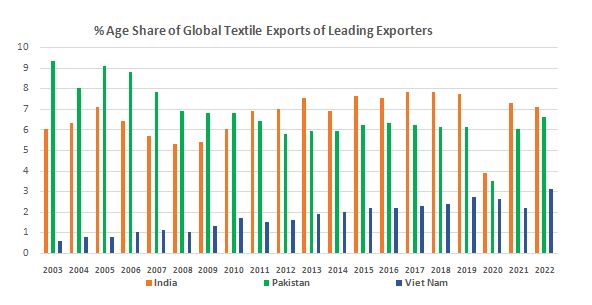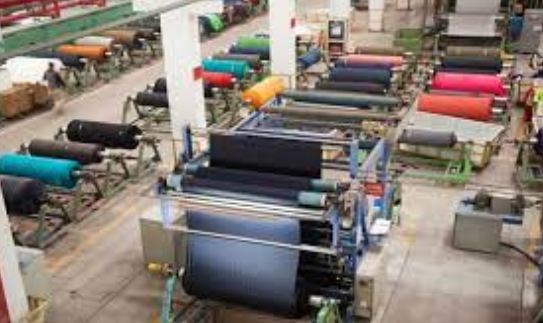By
Imran Ali
The most important production sector of Pakistan in terms of industrial production, GDP and international trade is textile sector. The textile sector produces are the most exported items of Pakistan. Textile sector in Pakistan is the largest production of Pakistan, it is considered be the 46% of the total manufacturing sector of Pakistan and generates more than 40% of the employment of the total labour force. However, for the last two decades the Textile Sector exports of Pakistan are exhibiting deteriorated performance, the decline in textile exports reveals the unsatisfactory competitive performance.
52% of the export of Pakistan are concentrated in a single value chain textile, apparel and cotton. Currently total exports of cotton, apparel and textile products values more than 18.12 billion. 18% of the total exports of Pakistan in 2022 comprises of textile products, more than 19% are apparel product and the share of cotton export has shrunk to 10% only.
Textile exports of Pakistan in 2003 were USD 2.3 billion, that have grown to USD 5.6 billion in 2023, however the share of Pakistan is shrinking in the global exports of textile sector. In 2003 around 10% of the total global exports were made by Pakistan which has shrink to 6.6% in 2023 with a persistent falling trend. Textile exports of Viet Nam were USD 0.13 billion in 2002 and with a persistent growth rate, Viet Nam’s total textile exports have grown into USD 3.1 billion in 2021 and USD 2.1 billion in 2022. Viet Nam has successfully enhanced it share in the global textile exports, in 2003 the global share of Viet Nam’s textile exports was mere 0.6% that has increased to 3.1% in 2022.

As compared to the regional competitor, textile sector of Pakistan unfortunately couldn’t sustain its growth due to incompetencies deep rooted in inefficiencies. Industrial growth in 1970s, 1990s and 2000 did not meaningfully translated into vertical and horizontal industrial intensification of the textile sector of Pakistan. A few supply chain actors have been keeping themselves updated and this sector has failed to sustain its competitiveness; due to failure to develop a market-oriented research and development as compared to the regional competitors.
The internal setbacks in the textile sector of Pakistan includes outdated technology, lack of automation and lack of rational standardization of the wool and threads. 33% of the machinery remains idle whole year. Innovation and diversification of the production is either not existent, outdated or not at par with the standard and requirement of the international market. Textile governing institution remains ineffective. Pakistani textile sector’s market concentration remains majorly two large buyers i.e., the European Union and the United States of America.
Shortages of raw cotton, scarcity and soaring prices of the fuels and electricity, depreciating exchange rate, inefficiency and non-availability of innovation centers and research institute, fluctuating raw material prices has further worsen the export performance of textile sector of Pakistan.
Wages and production costs in China are increasing, hence there is ample scope for the Pakistani textile industry to regain its competitiveness and its share in the international market. As per an estimate by the international Growth Center around USD 1 million spent on financings on twisting and knitting raises export by USD 0.27 million, and in Pakistan approximately 50,000 kegs filament of cotton generates employment opportunities for 400 people.
Pakistan’s textile sector possesses immense export potential however it has failed to export even half of the total potential. Export potential of Bedlinen of Cotton (HS Code 630231) is USD 1.7 billion for Pakistan while Pakistan’s total exports of the same produce are mere USD 982 million mere 53% of the total export’s potential.
The textile sector of Pakistan has been suffering primarily due to lack of serious efforts to enhance quality standards and diversifying the export produces. Serious and targeted interventions are need to curb the high manufacturing costs due to high raw material prices and hefty levies on import of cotton fibers. The subsidies scheme administered are often ill planned and lacks a proper framework based on achievable milestones aimed at enhancing production, marketing and export efficiencies.
Due to non-existence of a vibrant and robust supply value chain, adequate research and development center, and conducive environment, Pakistan has been unable to value add its cotton and untap the true export potential. Leveraging the China Pakistan Economic Corridor and entering into joint ventures and partnerships with Chinese counterparts may bring noticeable improvements. Human capacity development, enterprise capacity development should be prioritized to introduce new technologies, trend and evolution of new practices of processing, producing and exporting high-end products.
The writer is Director Research and Development at SAARC CCI.

















